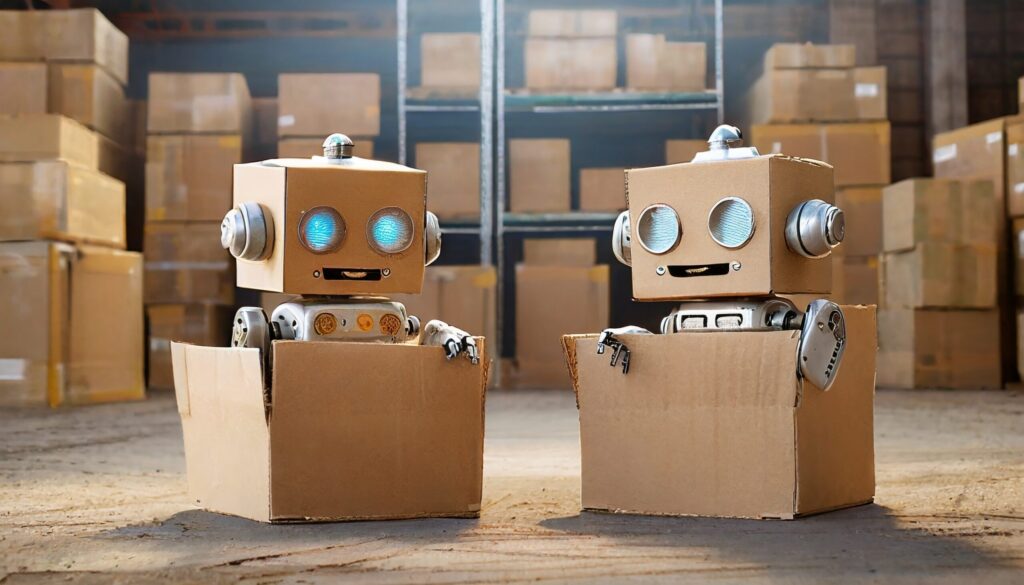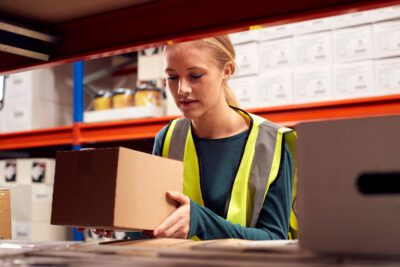Webinar Registration: The P2G Advantage
Webinar Registration: The P2G Advantage LEARN MORE
A History of Robots in the Warehouse: From da Vinci to the Future
Mary Hart, Senior Content Marketing Manager

Although robots may be something you haven’t considered for your warehouse with manual operations, the concept of robots has been around for a while. In fact, the term “robot” has been in use since before anyone reading this was born – unless you’re 103 or older. We’ve seen robots evolve from far-fetched science fiction to an indispensable part of modern supply chain and warehouse operations. Here’s a look back at how robots started, when they entered the industrial world, and what’s next for warehouses of the future.
The Beginning of Robots
Think robots are a new idea that came along recently? Ancient Greek myths contained primitive versions of robots in the form of Talos, the giant bronze man, as did Leonardo da Vinci’s forward-thinking sketches of humanoid automation. But it wasn’t until the 20th century that the science fiction of robots started becoming reality.
The word “robot” entered the world in 1920, coined by Czech writer Karel Čapek. His play “R.U.R.” envisioned a world where robots rebelled against humans, a theme echoed in many later sci-fi tales including “The Terminator” and more.
Pop culture robots weren’t always the big bad, though. They could also be helpful friends like Rosie (first known as “Rosey” before they changed the spelling of her name in season 2) on “The Jetsons” who would wheel around the room cleaning with her vacuum attachment. Who else wishes they had a Rosie to do housework and simply press one button and have a full-course meal emerge from the wall? You may not be able to do that, but robots certainly CAN help in warehouses, factories, and fulfillment centers.
When Robots Entered Factories
Back in the 1950s, before “The Jetsons” or “Terminator” came out, robotics were first developed for use in factories. The first true robots were created to take over repetitive and dangerous factory work, mimicking the main use of robots in warehouses today.
General Motors’ spot welding robot, the Unimate, hit assembly lines in 1961 and was added to GM’s Lordstown, Ohio plant in 1969. This was the beginning of warehouse and factory automation that handled tedious tasks.
Robots in the Warehouse
By the 1980s, computers and robotics had advanced enough to be applied in the warehouse environment. In fact, in 1981, Takeo Kanade built the first robotic arm that had motors installed directly into the joints of its arm. With the ability to move objects, robots began to help (just like Rosie the Robot) in warehouses doing basic functions such as palletizing and moving inventory short distances.
Even though robots were doing more, they lacked the ability to autonomously move and navigate on their own and make decisions. While innovations occurred in artificial intelligence for navigation and operation, human oversight and robots working alongside humans remained – and still remains to this day – essential in warehousing.
The New Age of Warehouse Robots
Cutting-edge technologies have spawned a new generation of intelligent warehouse robots. Today’s robots integrate artificial intelligence (AI), sophisticated sensors, cameras and navigation systems like LiDAR to help the robot move throughout a warehouse without being pushed or pulled. This enables full autonomy, allowing the robots to operate safely alongside human associates.
For instance, autonomous mobile robots (AMRs) can smoothly navigate dynamic warehouse environments. AMRs move safely around human associates and inventory to transport material or assist with picking and sorting. Some AMRs like LocusBots can even collaborate with humans, taking over repetitive tasks and enabling workers to upskill and focus on more rewarding activities.
Smart Warehouse Robots are Here
The innovation driving today’s smart warehouse robots has its roots in Greek mythology and science fiction, but it’s also making the future world a reality. From mythological beginnings to da Vinci’s sketches, robots have transformed into helpful and critical components of any warehouse, enhancing environments and making warehouses a “cool” place to work.
The integration of AI with robotics hasn’t just revolutionized operations; it’s beaming a light on a future where robots continue to amaze and help us in currently unimaginable ways. As robots evolve from fictional characters to warehouse heroes (alongside their human coworkers), they steer us towards a future that is interconnected, productive, and full of possibilities.
Let’s talk about how our robots can help your warehouse evolve into the world of automation.




